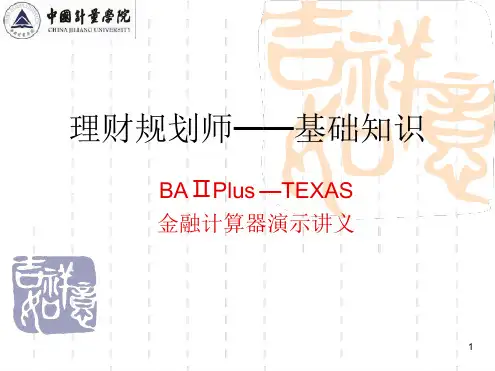个人理财金融理财计算器(德州仪器BAⅡ_PLUS完整版)
- 格式:pdf
- 大小:1.54 MB
- 文档页数:81
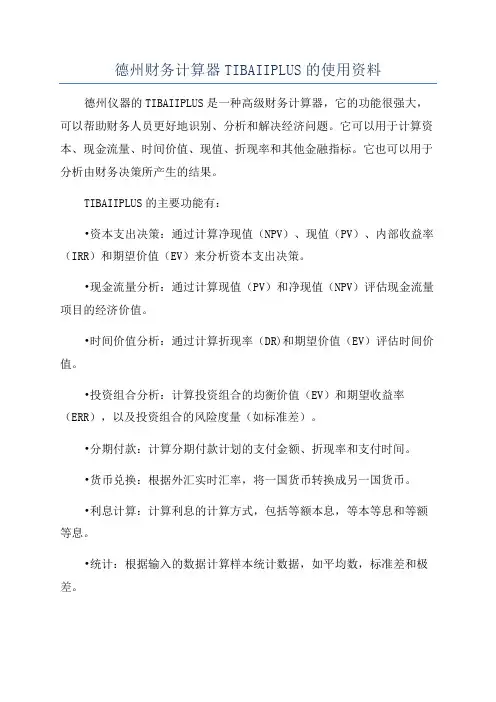
德州财务计算器TIBAIIPLUS的使用资料德州仪器的TIBAIIPLUS是一种高级财务计算器,它的功能很强大,可以帮助财务人员更好地识别、分析和解决经济问题。
它可以用于计算资本、现金流量、时间价值、现值、折现率和其他金融指标。
它也可以用于分析由财务决策所产生的结果。
TIBAIIPLUS的主要功能有:
•资本支出决策:通过计算净现值(NPV)、现值(PV)、内部收益率(IRR)和期望价值(EV)来分析资本支出决策。
•现金流量分析:通过计算现值(PV)和净现值(NPV)评估现金流量项目的经济价值。
•时间价值分析:通过计算折现率(DR)和期望价值(EV)评估时间价值。
•投资组合分析:计算投资组合的均衡价值(EV)和期望收益率(ERR),以及投资组合的风险度量(如标准差)。
•分期付款:计算分期付款计划的支付金额、折现率和支付时间。
•货币兑换:根据外汇实时汇率,将一国货币转换成另一国货币。
•利息计算:计算利息的计算方式,包括等额本息,等本等息和等额等息。
•统计:根据输入的数据计算样本统计数据,如平均数,标准差和极差。

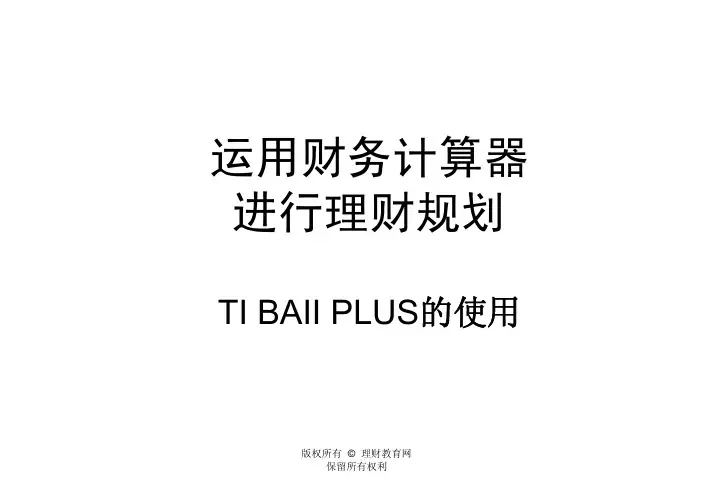
运用财务计算器进行理财规划TI BAII PLUS的使用版权所有©理财教育网2版权所有©理财教育网TI BAII PLUS 财务计算器TI BAII PLUS财务计算器的使用 计算器的基本设定货币时间价值(TVM)的计算TI BAII PLUS财务计算器的运用3版权所有©理财教育网TI BAII PLUS计算器的基本设定•主要功能按键: 都印在键上,如按右上方ON/OFF 键,开机关机。
•货币时间价值操作键:N为期数,I/Y为利率,PV为现值,PMT为年金,FV为终值。
•次要功能按键:按2ND切换键。
如按2ND ENTER,表示调用SET功能。
4版权所有©理财教育网小数位数的设置•小数位数的设置:默认为两位小数;更改设置时,依次按2ND FORMAT,进入格式设置选项,出现DEC=2.00,若要改为四位小数,输入4,再按ENTER,出现DEC=4.0000。
•考试时最好设为4位小数。
这样输入金额时可以万元计,结果精确到小数点后4位,答案可以精确到元。
•小数位数设置不会因开关机功能而改变,只有重新设置才会改变。
5版权所有©理财教育网数据的重新设置和清空•删除单个字符按•数字重新输入按CE/C键•一般计算重新设置:按2ND QUIT,显示0.0000,退出到主界面。
•N 、I/Y、PV、PMT、FV这五个货币时间价值功能键中会存有上次运算的结果,通过OFF或CE/C键无法清除其中数据。
按2ND CLR TVM清空。
•CF是输入现金流量计算NPV和IRR的功能键。
也会存有上次输入的现金流量。
如需清空,必须先进入CF后再按2ND CLR WORK。
•对于其它功能键中数据的清除,也都可以使用同一种方法。
比如:清空BOND键中的数据,先按2ND BOND进入债券工作表,再按2ND CLR WORK键。
•清除储存单元中保存的所有数据,可以先按2ND MEM进入存储器工作表,再按2ND CLR WORK键。

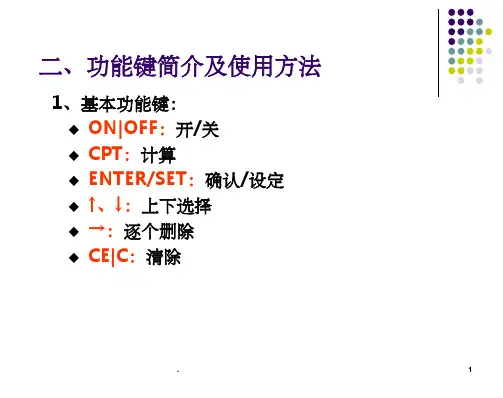
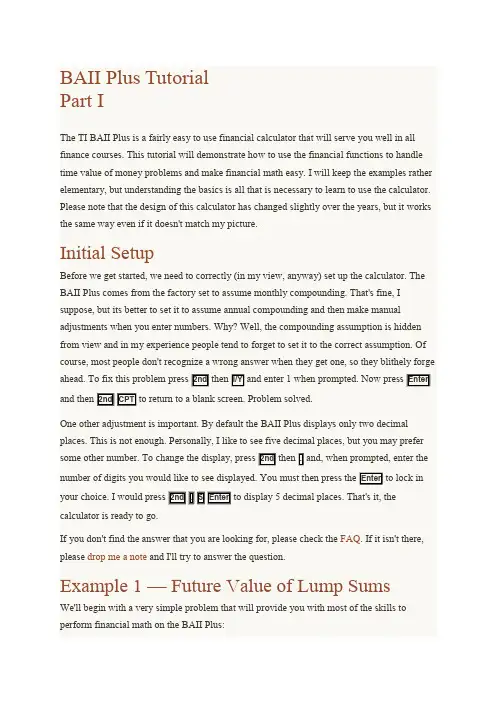
1.Calculate the total present value of each of the cash flows, starting from period 1 (leaveout the initial outlay). Use the calculator's NPV function just like we did in Example 3, above. Use the reinvestment rate as your discount rate to find the present value.2.Calculate the future value as of the end of the project life of the present value from step1. The interest rate that you will use to find the future value is the reinvestment rate.3.Finally, find the discount rate that equates the initial cost of the investment with thefuture value of the cash flows. This discount rate is the MIRR, and it can be interpreted as the compound average annual rate of return that you will earn on an investment if you reinvest the cash flows at the reinvestment rate.Suppose that you were offered the investment in Example 3 at a cost of $800. What is the MIRR if the reinvestment rate is 10% per year?Let's go through our algorithm step-by-step:So, we have determined that our project is acceptable at a cost of $800. It has a positive NPV, the IRR is greater than our 12% required return, and the MIRR is also greater than our 12% required return.。
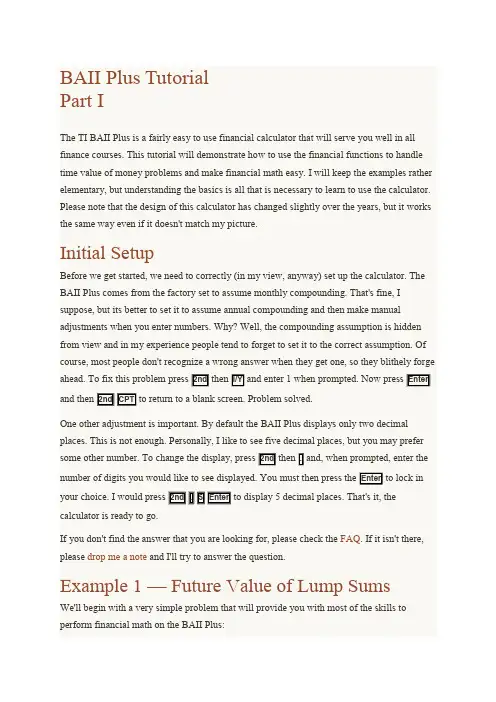
1.Calculate the total present value of each of the cash flows, starting from period 1 (leaveout the initial outlay). Use the calculator's NPV function just like we did in Example 3, above. Use the reinvestment rate as your discount rate to find the present value.2.Calculate the future value as of the end of the project life of the present value from step1. The interest rate that you will use to find the future value is the reinvestment rate.3.Finally, find the discount rate that equates the initial cost of the investment with thefuture value of the cash flows. This discount rate is the MIRR, and it can be interpreted as the compound average annual rate of return that you will earn on an investment if you reinvest the cash flows at the reinvestment rate.Suppose that you were offered the investment in Example 3 at a cost of $800. What is the MIRR if the reinvestment rate is 10% per year?Let's go through our algorithm step-by-step:So, we have determined that our project is acceptable at a cost of $800. It has a positive NPV, the IRR is greater than our 12% required return, and the MIRR is also greater than our 12% required return.。
